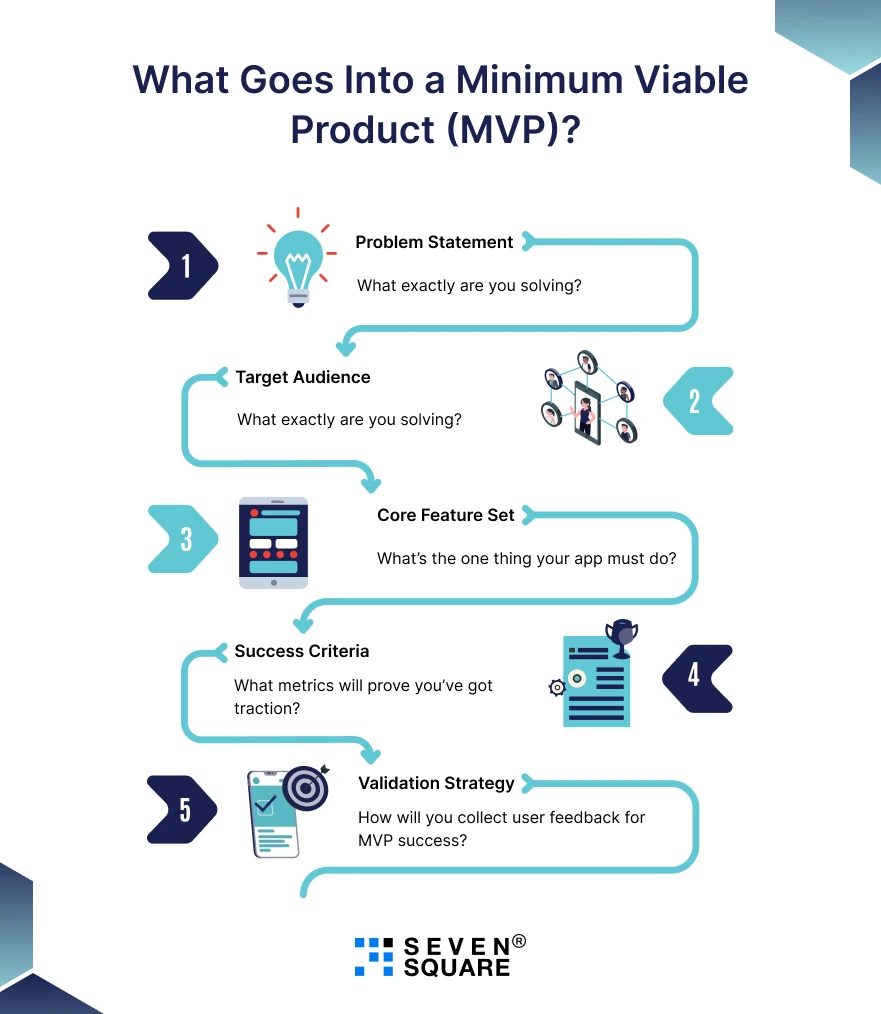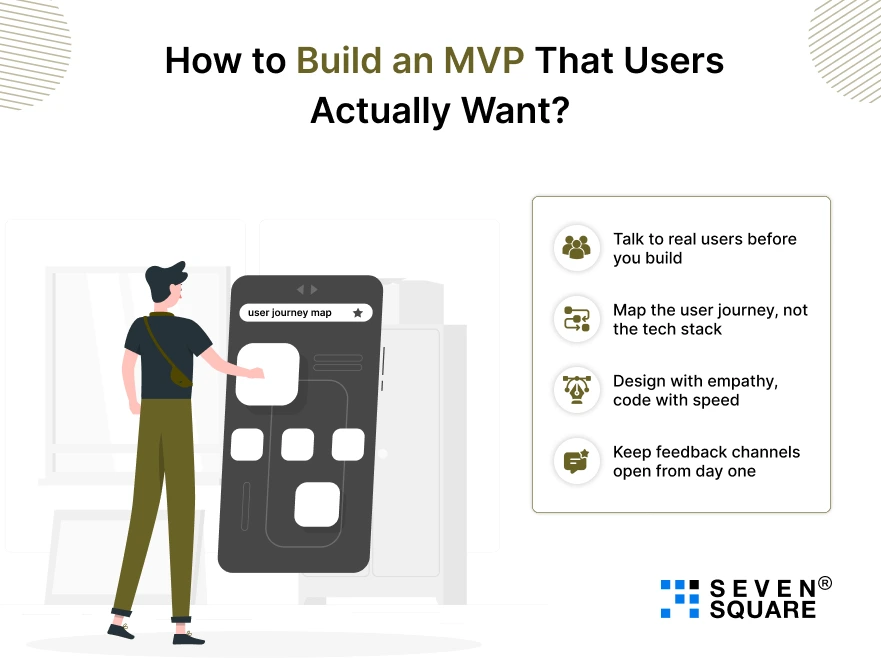Your developer just shipped yet another feature. It took two weeks, and no one’s using it.
Sound familiar?
You’re not alone. We’ve seen founders fall into this trap repeatedly: building too much, too early.
They pack in features, polish the UI endlessly, and delay launch, hoping for perfection. But that “perfect” MVP? It never actually connects with real users.
We’ve worked with dozens of startups across healthcare, logistics, eCommerce, and fintech. The ones that win?
They skip the fluff and validate the product idea with a real, working MVP. One that solves a real user problem. Fast. Here’s how you can do it too.
What are the Real Reason MVPs Fail?
Most MVPs don’t flop because of bad code. They fail because the team never validated the core product idea.
Let’s be clear: MVP doesn’t mean hacked together. It means laser-focused. The point of MVP development is to test if your idea solves a real problem, with the least effort and the highest learning.
Avoid overbuilding by defining what “minimum” actually means. If it doesn’t directly help validate product-market fit, it doesn’t go in your MVP.
It is necessary to validate product idea with MVP to see if it can fit in the market.
Build MVP for Startup Ideas with Focus, Not Fear
When you’re building your MVP, remember: this is not your final product. It’s a test.
Many founders fear they’ll be judged for launching something small or incomplete. But the opposite is true.
Early adopters expect your startup MVP to be lean. They value progress and honesty over bells and whistles.
It can be difficult to build MVP for startup idea if it isn’t tried and tested first.
So strip it down. Your MVP should:
- Solve one painful user problem.
- Be usable enough for feedback.
- Be fast enough to launch and iterate.
Still unsure how to build MVP app the right way? Don’t worry, we’ve got your back.
What Goes Into a Minimum Viable Product (MVP)?

Building a solid MVP starts with clarity:
1. Problem Statement: What exactly are you solving?
2. Target Audience: Who is facing this problem?
3. Core Feature Set: What’s the one thing your app must do?
4. Success Criteria: What metrics will prove you’ve got traction?
5. Validation Strategy: How will you collect user feedback for MVP success?
Use the Lean startup methodology to keep every decision tied to learning. Your goal isn’t to build more. It’s to learn more.
Remember: You’re not building MVP app for you. You’re building to test how real users respond.
MVP Features: Less Is More
Don’t throw in five onboarding flows, four dashboards, and a chatbot “just in case.” Avoiding feature creep in MVP development is critical.
Ask yourself: if a feature doesn’t help test product-market fit, why are we building it?
Pro tip: At Seven Square, we use a brutal filter, if we can’t explain how a feature helps validate the idea or generate user feedback within two sprints, it’s out.
Focus your MVP features on:
- Solving the user’s core problem
- Enabling feedback loops
- Supporting fast iteration
We believe that it is necessary to validate product idea with MVP to make it successful.
MVP Validation: Real Feedback or Bust
You can’t validate product idea with MVP if you’re not talking to real users.
User interviews are great, but actual usage is better. Real feedback comes from real usage. That means:
- Launching fast
- Tracking user behavior
- Asking smart follow-up questions
Steps to validate MVP with real users:
- Share the MVP with a small, targeted user group.
- Measure task completion and friction.
- Interview users right after use.
- Repeat until patterns emerge.
Early user feedback for MVP reveals what to fix, what to drop, and what to double down on. Without it, you’re just guessing.
Startup Product Development the Smart Way
A lot of teams confuse product development with feature shipping. The truth? Building an MVP is about learning, not launching.
At Seven Square, our startup product development approach pairs engineering with product thinking. We don’t just build MVP for startup ideas but we help you decide why and what to build first.
That’s how we’ve helped 50+ startups move fast, stay lean, and launch with confidence.
Trying to figure out how to build MVP app for the growth of your business? We are here for you.
From fintech dashboards to healthcare apps, our MVPs deliver working tech that people actually use.
What Are the Common MVP Pitfalls (And How to Avoid Them)?
You don’t need to learn the hard way. Here are the traps to avoid:
- Overbuilding before validating
- Skipping user testing due to time pressure
- Too many features, not enough clarity
- No clear success metrics
- Fear of launching early
The best MVPs don’t launch perfect but they launch with purpose.
MVP Testing: Don’t Just Ship, Learn
Every MVP launch should come with a clear test plan:
- What are we testing?
- What will success look like?
- What happens if it fails?
Use tools to track:
- Drop-off rates
- Usage of heatmaps
- Task success rates
These are gold when it comes to MVP testing and validation. It’s not just about clicks but it’s about comprehension, friction, and outcomes.
Best practices for MVP testing and validation include:
- A/B testing small changes
- Fast feedback loops
- Weekly learn-and-adjust cycles
Learn about top automation testing tools that you can use to validate idea MVP and its testing.
How to Build an MVP That Users Actually Want?

We’ll say it again: MVPs are not for impressing VCs. They’re for understanding users.
So how do you build an MVP that users want?
- Talk to real users before you build
- Map the user journey, not the tech stack
- Design with empathy, code with speed
- Keep feedback channels open from day one
At Seven Square, we build MVPs that reflect this mindset, just fast-moving, feedback-driven software.
You also need to learn about MVP vs Prototype to understand when to go for MVP.
We also bake in the ability to pivot early. So if the user needs a shift? You’re not stuck. You’re ready.
MVP Launch Strategy That Doesn’t Waste Time
You don’t need a massive launch.
In fact, most successful startup MVPs launch quietly to a specific group of early adopters.
Here’s how to launch smart:
- Choose 25–50 target users
- Send personal invites
- Provide simple onboarding
- Set clear expectations (this is a test!)
- Follow up after 48 hours for insights
Small launches = faster feedback = better iterations. That’s how you win early.
How We Build MVPs That Actually Move the Needle?
We don’t just write code, we help founders and product teams make sharper decisions.
That means building Minimum Viable Products (MVPs) that are lean, fast, and focused on what users actually care about.
No guesswork. No bloated features. Just smart MVP development built to validate product ideas and gather real feedback.
1. Take CountMee, for example, which is a multi-pickup and same-day delivery app.
- The founder needed to test the waters fast, so we started with a core MVP: just the essentials to see if users would bite. And they did.
- Once traction was there, we scaled it up—adding an admin dashboard, batch delivery management, and multi-location features. No overbuilding. Just thoughtful, data-backed product development.
2. Or look at SummaryAI, a tool that uses AI to transcribe audio and video.
- We launched the MVP with a clean homepage, user registration, dashboard, and workspace.
- That gave our client just enough to test the core value prop and get users on-board without burning months in development.
That’s our playbook:
- Identify the core features that matter
- Launch quickly, validate with real users
- Gather insights
- Then build what’s actually needed
We’ve built MVPs for industries like logistics, AI tools, fintech, on-demand services you name it.
With a team of 50+ engineers and product thinkers, we mix speed, clarity, and technical depth to deliver MVPs that stand up in the real world.
Thinking of building an MVP? Let’s make it.
Don’t Build More. Learn More.
Every day you spend perfecting a feature nobody asked for is a day lost. Build MVP with intention. Build for learning. Build for users.
The smartest founders we’ve worked with didn’t launch fast because they were reckless & they did it because they knew exactly what they needed to learn.
If you’re a founder or product manager trying to navigate MVP development, remember:
- Less is more
- Launching is learning
- Feedback is everything
Don’t waste months overbuilding. The best MVPs aren’t bloated but they’re bold.
So start small. Listen hard. Move fast.
And build something people actually want.
FAQs
- An MVP is a simplified version of your product that includes only the core features necessary to solve a user’s main problem.
- It’s designed to validate your product idea with real users before investing in full-scale development.
- Building an MVP helps startups avoid overbuilding and wasting resources.
- It allows you to test your product-market fit, collect user feedback, and pivot early if needed all without burning your entire budget.
- Validation starts with launching to a small group of early adopters. Use surveys, interviews, analytics, and behavior tracking to collect user feedback.
- The goal is to learn whether users are actually engaging with your core value proposition.
- Some classic mistakes include: building too many features, ignoring user feedback, skipping validation, and chasing perfection.
- MVP development is not about getting it “right” the first time but it’s about learning fast.
- Yes, even complex ideas can be broken into smaller, testable pieces.
- For example, we’ve built MVPs for AI transcription tools and logistics platforms by isolating their most valuable use cases first.